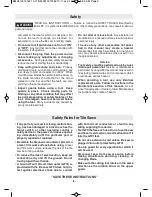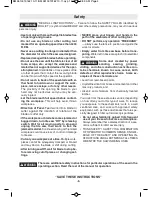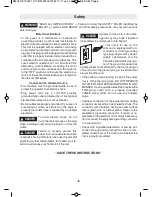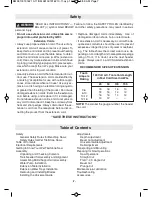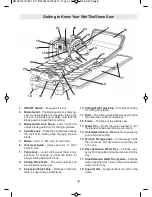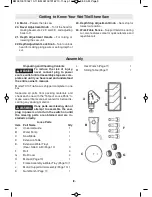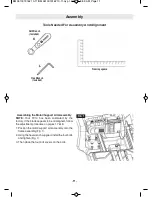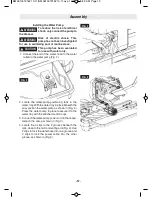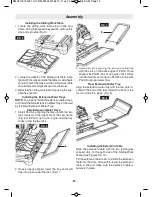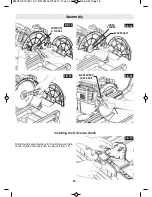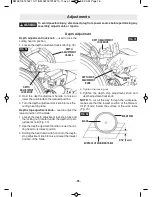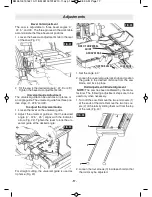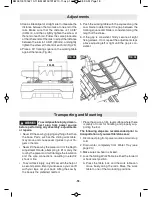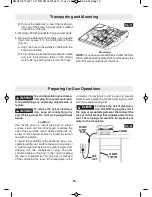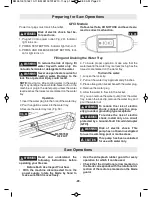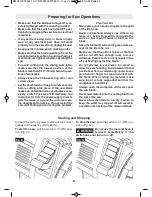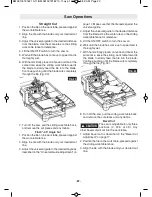
-7-
Safety
General Safety Rules for Benchtop Saws
Safety Rules for Wet Tile/Stone Saws
Table of Contents
Electrical Requirements
Getting to Know Your Wet Tile/Stone Saw
Assembly
Unpacking and Checking Contents
Tools Needed for Assembly and Alignment
Assembling Motor/Support Arm Assembly
Water Pump Installation
Extension Table Installation
Extension Water Trays Installation
Removing and Installing Blades
Installing the Universal Guide
Adjustments
Depth Adjustment
Bevel Cut Adjustment
Universal Guide Adjustment
Rail Adjustment
Transporting and Mounting
Preparing for Saw Operations
Saw Operations
Straight Cut
Flat 0°- 45° Angle Cut
Bevel Cut
Plunge Cut
Maintenance & Lubrication
Troubleshooting
Accessories
Table of Contents
•
Do not use extension cord unless tile saw is
pluged into outlet protected by GfCI.
Extension Cords
• Always use proper extension cord. The use of any
extension cord will cause some loss of power. To
keep this to a minimum and to prevent overheating
and motor burn-out, use the table below to deter-
mine the minimum wire size (A.W.G.) extension
cord. Use only 3-wire extension cords which have
3-prong grounding type plugs and 3-pole recepta-
cles which accept the tool’s plug. Make sure your
extension cord is in good condition.
• Use only extension cords that are intended for out-
door use. These extension cords are identified by
a marking “Acceptable for use with outdoor appli-
ances, store indoors while not in use.” Use only ex-
tension cords having an electrical rating equal to
or greater than the rating of the product. Do not use
damaged extension cords. Examine the extension
cord before using, and replace it if it is damaged.
Do not abuse extension cords, and do not yank on
any cord to disconnect it. Keep the cord away from
heat and sharp edges. Always disconnect the ex-
tension cord from the receptacle before discon-
necting the product from the extension cord.
• Replace damaged cords immediately. Use of
damaged cords can shock, burn or electrocute.
• If an extension cord is necessary, a cord with ade-
quate size conductors should be used to prevent
excessive voltage drop, loss of power or overheat-
ing. The table shows the correct size to use, de-
pending on cord length and nameplate amperage
rating of tool. If in doubt, use the next heavier
gauge. Always use U.L. and CSA listed extension
cords.
RECOMMENDED SIzES Of ExTENSION
NOTE:
The smaller the gauge number, the heavier
the cord.
Tool’s
Ampere
Rating
0-6
6-10
10-12
12-16
18 16 16 14
18 16 14 12
16 16 14 12
14 12 – –
120 Volt A.C. Tools Cord length
in feet Cord Size in A.W.G.
25 50 100 150
“READ ALL INSTRUCTIONS” — Failure to follow the SAFETY RULES identified by
BULLET (•) symbol listed BELOW and other safety precautions, may result in serious
personal injury.
!
WARNING
Safety
“SAVE THESE INSTRUCTIONS”
BM 2610019162 10-11:BM 2610019162 10-11.qxp 10/20/11 8:59 AM Page 7



